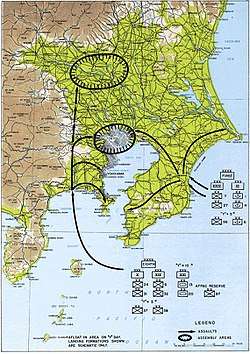Japanese Twelfth Area Army
The Japanese Twelfth Area Army (第12方面軍, Dai-jūni hōmen gun) was a field army of the Imperial Japanese Army during World War II.
| Japanese Twelfth Area Army | |
|---|---|
 Invasion Map for Tokyo region during Operation Downfall | |
| Active | February 1, 1945 - August 15, 1945 |
| Country | |
| Branch | |
| Type | Infantry |
| Role | Field Army |
| Garrison/HQ | Tokyo |
| Nickname(s) | 幡(Hata = “banner”) |
| Engagements | Operation Downfall |
History
The Japanese 12th Area Army was formed on February 2, 1945 under the First General Army as part of the last desperate defense effort by the Empire of Japan to deter possible landings of Allied forces in central Honshū during Operation Downfall (or Operation Ketsugō (決号作戦, Ketsugō sakusen) in Japanese terminology).[1] The Japanese 12th Area Army was responsible for the Kantō region of Japan and was headquartered in Tokyo.
It consisted mostly of poorly trained reservists, conscripted students and home guard militia. In addition, the Japanese had organized the Volunteer Fighting Corps — which included all healthy men aged 15–60 and women 17–40 — to perform combat support, and ultimately combat jobs. Weapons, training, and uniforms were generally lacking: some men were armed with nothing better than muzzle-loading muskets, longbows, or bamboo spears; nevertheless, they were expected to make do with what they had.[2]
The 12th Area Army was demobilized at the surrender of Japan on September 2, 1945 without having seen combat.
List of Commanders
Commanding officer
| Name | From | To | |
|---|---|---|---|
| 1 | General Keisuke Fujie | February 1, 1945 | March 9, 1945 |
| 2 | General Shizuichi Tanaka | March 9, 1945 | August 24, 1945 |
| 3 | General Kenji Doihara | August 25, 1945 | September 2, 1945 |
Chief of Staff
| Name | From | To | |
|---|---|---|---|
| 1 | Lieutenant General Eiichi Tatsumi | February 1, 1945 | March 1, 1945 |
| 2 | Major General Tatsuhiko Takashima | March 1, 1945 | August 25, 1945 |
References
Books
- Drea, Edward J. (1998). "Japanese Preparations for the Defense of the Homeland & Intelligence Forecasting for the Invasion of Japan". In the Service of the Emperor: Essays on the Imperial Japanese Army. University of Nebraska Press. ISBN 0-8032-1708-0.
- Frank, Richard B (1999). Downfall: The End of the Imperial Japanese Empire. New York: Random House. ISBN 0-679-41424-X.
- Jowett, Bernard (1999). The Japanese Army 1931-45 (Volume 2, 1942-45). Osprey Publishing. ISBN 1-84176-354-3.
- Madej, Victor (1981). Japanese Armed Forces Order of Battle, 1937-1945. Game Publishing Company. ASIN: B000L4CYWW.
- Marston, Daniel (2005). The Pacific War Companion: From Pearl Harbor to Hiroshima. Osprey Publishing. ISBN 1-84176-882-0.
- Skates, John Ray (1994). The Invasion of Japan: Alternative to the Bomb Downfall. New York: University of South Carolina Press. ISBN 0-87249-972-3.
External links
- Wendel, Marcus. "Axis History Factbook". Japanese Twelfth Area Army.
Notes
- Skates, The Invasion of Japan: Alternative to the Bomb Downfall
- Frank, Downfall, p. 188–9. Bauer and Coox, OLYMPIC VS KETSU-GO.